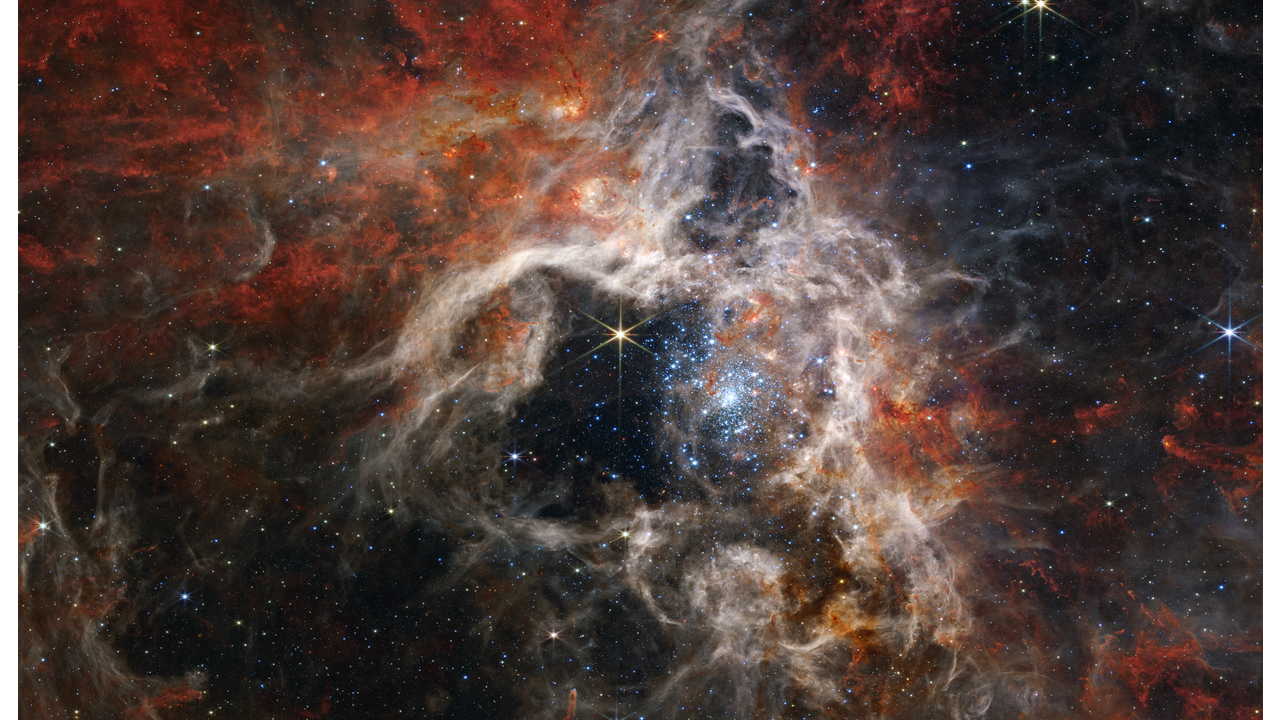A New Era for Astronomy and Cosmology
With LIGO, JWST the construction of the Square Kilometer Array, and the ICECUBE Neutrino detector, we are opening new windows on the Universe. If history is any guide, we will be surprised.
This photograph, recently released by the James Webb Space Telescope, is of the Tarantula Nebula, a star forming region in our galaxy. Because of its unique capability of detecting infrared radiation, the JWST image pierces was was before a shroud of cosmic dust. As described on the NASA JWST site, this image “including tens of thousands of never-before-seen young stars that were previously shrouded in cosmic dust. The most active region appears to sparkle with massive young stars, appearing pale blue. Scattered among them are still-embedded stars, appearing red, yet to emerge from the dusty cocoon of the nebula. NIRCam is able to detect these dust-enshrouded stars thanks to its unprecedented resolution at near-infrared wavelengths….Farther from the core region of hot young stars, cooler gas takes on a rust color, telling astronomers that the nebula is rich with complex hydrocarbons. This dense gas is the material that will form future stars.”
New images are being released almost daily, but JWST. Here is another one,
These infrared images are of Saturn’s largest moon, Titan, the only moon with a dense atmosphere (and rivers, lakes, and seas of liquid methane). JWST was able to spot the existence of two clouds on Titan,, long predicted to exist. By observing these clouds, in tandem with terrestrial observatories, the dynamics of Titan’s atmosphere can be explored.
These new images form part of a new era in Astronomy. While the Hubble Space Telescope was able to provide spectacular visual images of the Universe, and has helped push both Astronomy and Cosmology forward, over the last decade, and this upcoming decade, our windows on the universe have been expanding to go well beyond what we can detect with visible light.
Besides JWST, about which I have written before, the LIGO gravitational wave observatory has already detected almost 100 gravitational wave events, demonstrating not just the existence of massive black holes in the range of 30-70 solar masses, but also the collisions of neutron stars, allowing observers to detect, in real time, the formation of heavy elements in the Universe. Long a mystery, it was theorized that perhaps gold formed in the merger of neutron stars. Following on the detection of gravitational waves from one neutron star collision, X-ray and gamma ray detectors were able to capture the signature of over 1 earth mass in gold during that single event. If any of you wear gold rings or other accessories, look down at them and realize that the atoms you are wearing were formed in one of the most exotic events in the universe, the collision of two dense neutron stars!
It was recently the ICECUBE neutrino detector—in which a large region of clear ice deep under the surface in Antarctica has been instrumented to detect light pulses from the collisions of ultra-high energy neutrinos from distant sources—reported detecting the first such events from a known distant galaxy. These are among the highest energy cosmic rays in the universe, and as we detect more events this will shed light on new exotic processes in nature.
Finally, this week, construction began, after 30 years of planning, on the largest radio telescope array in the world, the so called Square Kilometer Array (SKA) to be located in both South Africa and Australia. With over 100,000 separate antennas, whose signals will be combined, the SKA will have resolving power of a telescope with a receiving area of a square kilometer! This will allow astronomers and physicists to probe the early universe in unprecedented detail, shedding light on the formation of galaxies, and perhaps even the nature of dark matter. The first phase of this multi billion dollar project is slated to be completed in 2028.
While each of these new windows on the Universe was designed with known targets in mind, the most exciting likely results will be those that are entirely unexpected. Every time we have opened similar new windows on the Universe we have been surprised. I see no reason to expect this trend to end.
In my new book to be released next May, whose UK version is entitled The Known Unknowns, I have written about what we know we don’t know about the universe. These are the questions that drive our current voyage of discovery. But, it is the unknown unknowns, which we cannot yet write about, but which will be the fodder for books yet to be written in this century, that may change our picture of the Universe in the most dramatic ways.
As every traveler knows, including the travelers we take on our Origins Project Foundation expeditions to places like Greenland, it is the things you never expected to see that create the memories that last a lifetime. So too in science. These unexpected discoveries are what will define the science of the future. We will never make them, however, if we stop looking outward. Fortunately the current era has a vast new set of windows opening on the cosmos. Stay Tuned!






Lawrence, what are your thoughts on the size of the galaxies at redshift z~13 that JWST has discovered?
https://blogs.nasa.gov/webb/2022/12/09/nasas-webb-reaches-new-milestone-in-quest-for-distant-galaxies/
Some are saying they are too large and potentially incompatible with LCDM. https://arxiv.org/abs/2208.01611
Not enough baryonic mass for the size of those early galaxies?
What do you think?
LIGO acronym stands for Laser Interferometer Gravitational-Wave Observatory, in case anyone didn’t know which I doubt if they are reading this.